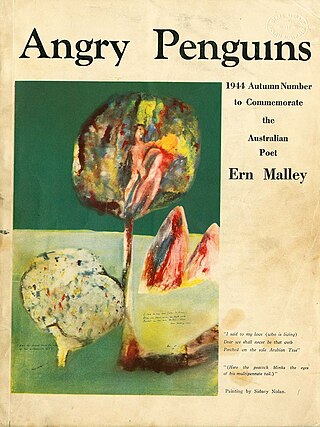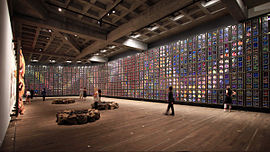
The Mona Lisa is a half-length portrait painting by Italian artist Leonardo da Vinci.

The Ern Malley hoax, also called the Ern Malley affair, is Australia's most famous literary hoax. Its name derives from Ernest Lalor "Ern" Malley, a fictitious poet whose biography and body of work were created in one day in 1943 by conservative writers James McAuley and Harold Stewart in order to hoax the Angry Penguins, a modernist art and literary movement centred around a journal of the same name, co-edited by poet Max Harris and art patron John Reed, of Heide, Melbourne.

The Gwion Gwion rock paintings, Gwion figures, Kiro Kiro or Kujon are one of the two major regional traditions of rock art found in the north-west Kimberley region of Western Australia. The identity of the artists and the age of the art are contended within archaeology and amongst Australian rock art researchers. A 2020 study estimates that most of the anthropomorphic figures were created 12,000 years ago, based on analysis of painted-over wasps' nests. These aspects have been debated since the works were seen, and recorded, in 1891 by pastoralist Joseph Bradshaw, after whom they were named until recent decades. As the Kimberley is home to many traditional owners, the rock art is referred to and known by many different names in the local languages, the most common of which are Gwion Gwion or Kiro Kiro/Giro Giro. The art consists primarily of human figures ornamented with accessories such as bags, tassels and headdresses.

Sir George Russell Drysdale, also known as Tass Drysdale, was an Australian artist. He won the prestigious Wynne Prize for Sofala in 1947, and represented Australia at the Venice Biennale in 1954. He was influenced by abstract and surrealist art, and "created a new vision of the Australian scene as revolutionary and influential as that of Tom Roberts".

Albert Lee Tucker was an Australian artist and member of the Heide Circle, a group of modernist artists and writers associated with Heide, the Melbourne home of art patrons John and Sunday Reed. Along with Heide Circle members such as Sidney Nolan and Arthur Boyd, Tucker became associated with the Angry Penguins art movement, named after a publication founded by poet Max Harris and published by the Reeds.

The Antipodeans were a group of Australian modern artists who asserted the importance of figurative art, and protested against abstract expressionism. Though they staged but a single exhibition in Melbourne during August 1959, they were noted internationally.
Bundanon is a national arts organisation situated near Nowra, City of Shoalhaven, New South Wales, Australia. It was the home of the painter Arthur Boyd. Established as a national Trust in 1993, The organisation creates learning programs for students of all ages and operates Australia's largest artist in residence program. Bundanon promotes the value of landscape.
John Harford Reed was an Australian art editor and patron, notable for supporting and collecting of Australian art and culture with his wife Sunday Reed.

Sunday Reed was an Australian patron of the arts. Along with her husband, Reed established what is now the Heide Museum of Modern Art.

The Holy Virgin Mary is a mixed media painting created by Chris Ofili in 1996 that utilizes elephant dung and pornographic images. It was one of the works included in the Sensation exhibition in London, Berlin and New York in 1997–2000. The subject of the work, and its execution, caused considerable controversy in New York, with Rudolph Giuliani – then Mayor of New York City – describing Ofili's work as "sick". In 1998, Ofili was the first black artist to be awarded the Turner Prize. The painting was sold for £2.9 million in June 2015, and was gifted to the Museum of Modern Art in New York City in 2018.
Kirsha Kaechele is an American contemporary art curator, artist, and practitioner of sustainable building design. She is founder of KKProjects, Life is Art Foundation.
Mona Rockman Napaljarri is a Warlpiri-speaking Indigenous artist from Australia's Western Desert region. Her paintings and pottery are held in the collection of the National Gallery of Victoria.

The Museum of Old and New Art (MONA) is an art museum located within the Moorilla winery on the Berriedale peninsula in Hobart, Tasmania, Australia. It is the largest privately funded museum in the Southern Hemisphere. MONA houses ancient, modern and contemporary art from the David Walsh collection. Noted for its central themes of sex and death, the museum has been described by Walsh as a "subversive adult Disneyland".
David Dominic Walsh is an Australian professional gambler, art collector and businessman. He is the owner of the Museum of Old and New Art (MONA) and Moorilla Estate.

Nathan Wyburn is a Welsh variety act artist and media personality who has created celebrity portraits (iconography) and pop culture imagery using non-traditional media such as foodstuffs and other household items, most notably working with Marmite on toast. He has personally created works of art for Tom Holland, Prince William & Kate Middleton, Charles III, Mariah Carey, Dame Shirley Bassey, Sir Tom Jones, Debbie Harry, Sting, Catherine Zeta-Jones, Idris Elba, and The Jacksons.

Elwyn (Jack) Lynn was an Australian artist, author, art critic and curator.

Footballer is a 1946 painting by Australian artist Sidney Nolan. It depicts an Australian rules footballer standing before a crowd of spectators at a football match. For many years the painting was thought to be a generic image of a footballer, however Nolan later revealed that the painting is based on Bill Mohr, a star player for the St Kilda Football Club during the 1930s.

Sir Sidney Robert Nolan was one of Australia's leading artists of the 20th century. Working in a wide variety of media, his oeuvre is among the most diverse and prolific in all of modern art. He is best known for his series of paintings on legends from Australian history, most famously Ned Kelly, the bushranger and outlaw. Nolan's stylised depiction of Kelly's armour has become an icon of Australian art.

Anthony White is an Australian visual artist. A National Art School, Sydney, graduate, White has worked and lived in Paris since 2009. White has held solo exhibitions in Melbourne, Sydney, Paris, Latvia, London and Hong Kong.
The Museum of Modern Art Australia (MOMAA), alternatively named the 'Museum of Modern Art of Australia,' or, according to McCulloch, the 'Museum of Modern Art and Design' (MOMAD), was founded by Australian art patron John Reed in 1958 in Tavistock Place, a lane-way off 376 Flinders Street, Melbourne, launched previously with a survey of Modernist Victorian women artists on 1 June 1956, organised by the Reeds who had taken on the then named Gallery of Contemporary Art. It held exhibitions of important contemporary Australian and international art of the late 1950s and early 1960s. The Museum operated until 1966 and was formally dissolved in 1981.














